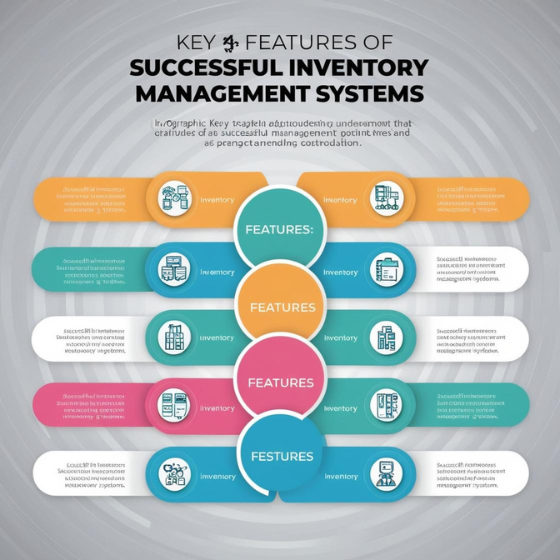Key Features of Successful Inventory Management Systems
Imagine this: A business seamlessly tracks its inventory, avoids stockouts, and never ties up capital in unnecessary overstock. Sounds ideal, right? This efficiency is possible with Key Features of Successful Inventory Management Systems, a cornerstone for operational success.
In today’s competitive business environment, an effective inventory management system can mean the difference between streamlined success and operational chaos. In this blog, we’ll uncover the features that make these systems indispensable, providing actionable insights into their role in transforming businesses.
Why Businesses Need Successful Inventory Management Systems
The Challenge of Managing Inventory
Managing inventory manually or through outdated systems is rife with challenges such as:
- Inaccurate stock counts.
- High holding costs due to overstocking.
- Missed sales opportunities due to stockouts.
- Inefficient supply chain processes.
Businesses that implement systems with Key Features of Successful Inventory Management Systems mitigate these challenges, unlocking greater productivity and profitability.
The Rewards of Getting It Right
According to a study, businesses that use robust inventory management systems experience a 25% increase in operational efficiency and a 20% reduction in carrying costs. These metrics underline the importance of investing in the right technology.
Key Features of Successful Inventory Management Systems
What sets an effective inventory management system apart? Let’s explore the must-have features that ensure smooth operations and efficiency.
1. Real-Time Inventory Tracking
One of the Key Features of Successful Inventory Management Systems is real-time tracking. This feature enables businesses to:
- Monitor inventory levels across multiple locations.
- Prevent stockouts and overstocking.
- Make informed decisions with up-to-date data.
Example: A retail chain using real-time tracking identified fast-moving products and optimized restocking schedules, increasing sales by 15%.
2. Demand Forecasting
Accurate demand forecasting leverages historical data and market trends to predict future inventory needs. Benefits include:
- Reduced inventory holding costs.
- Enhanced customer satisfaction due to timely product availability.
Pro Tip: Combine demand forecasting with sales trends for a holistic approach to inventory planning.
3. Seamless Integration with Other Systems
Effective inventory management systems integrate seamlessly with:
- Enterprise Resource Planning (ERP) platforms for centralized data management.
- Point-of-Sale (POS) systems to sync sales and inventory levels.
- E-commerce platforms to manage online and offline stock.
Seamless integration ensures data consistency, streamlining operations.
4. Automation and Alerts
Automation reduces human error and increases efficiency. Features include:
- Automated purchase orders for low-stock items.
- Alerts for slow-moving or obsolete inventory.
- Dynamic pricing adjustments based on stock levels.
5. Advanced Analytics and Reporting
Analytics provide actionable insights into inventory performance. Key benefits:
- Identify best-selling and slow-moving products.
- Optimize supply chain strategies.
- Make data-driven decisions for growth.
Real-World Impact: Case Studies
Case Study: E-commerce Startup’s Inventory Overhaul
An e-commerce startup struggled with inventory inconsistencies, leading to delayed shipments and dissatisfied customers. By adopting a system with Key Features of Successful Inventory Management Systems, they achieved:
- 30% faster order fulfillment.
- 25% reduction in inventory holding costs.
- Improved customer satisfaction ratings.
This transformation highlights the tangible benefits of investing in the right tools.
Steps to Implement a Successful Inventory Management System
Step 1: Assess Your Needs
Evaluate your current inventory management challenges. Key questions include:
- What inefficiencies do you face?
- Do you require real-time tracking?
- Is integration with existing tools necessary?
Step 2: Choose the Right Solution
Look for systems offering features like automation, forecasting, and analytics. Cloud-based solutions often provide scalability for growing businesses.
Step 3: Train Your Team
Ensure your team understands how to use the new system effectively. Provide training sessions and ongoing support.
Step 4: Monitor and Optimize
Regularly review system performance and adjust processes to maximize efficiency.
Looking for a tailored solution? Explore Sodio’s custom inventory management software here.
Latest Trends in Inventory Management Systems
Stay ahead of the curve by leveraging these trends:
1. AI-Powered Forecasting
Artificial Intelligence improves demand predictions, reducing waste and ensuring optimal stock levels.
2. IoT Integration
IoT devices like smart shelves and RFID tags provide real-time inventory updates, enhancing tracking accuracy.
3. Blockchain for Transparency
Blockchain ensures a transparent and tamper-proof inventory record, improving trust in supply chains.
4. Mobile Access
Mobile-friendly systems allow users to manage inventory on the go, perfect for dynamic business environments.
Overcoming Common Challenges
Implementing a system with the Key Features of Successful Inventory Management Systems comes with its own set of challenges. Here’s how to address them:
- Resistance to Change: Communicate the system’s benefits and provide comprehensive training.
- Data Migration Issues: Partner with experts like Sodio for seamless migration.
- Cost Concerns: Opt for scalable solutions that align with your budget and needs.
Why Choose Sodio?
Sodio specializes in crafting inventory management systems tailored to your business needs. With our expertise, you’ll benefit from:
- Enhanced operational efficiency.
- Reduced costs through better inventory control.
- A scalable solution designed for your growth.
Our clients have experienced tangible improvements in efficiency and customer satisfaction. Join them by exploring our services here.
Conclusion
Effective inventory management is the backbone of successful business operations. By implementing a system with the Key Features of Successful Inventory Management Systems, you can reduce costs, improve efficiency, and boost customer satisfaction.
Are you ready to elevate your inventory management game? Contact Sodio today to discover tailored solutions that will transform your operations. Let’s achieve success together!







